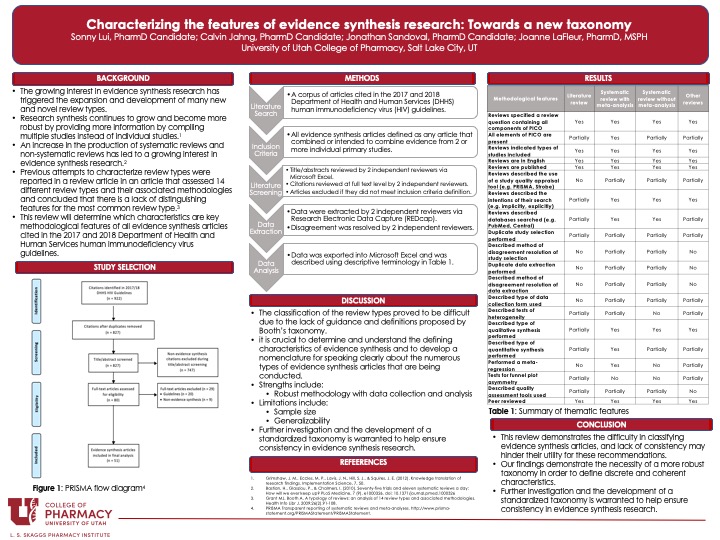Characterizing the features of evidence synthesis research: Towards a new taxonomy

Purpose: Clear communication in medical science is essential to interpret research findings accurately. In evidence synthesis, considerable ambiguity exists in the authors’ terminology related to a variety of methodological approaches. Our goal is to characterize the range of various methodologies by identifying critical features of evidence synthesis articles among a corpus of such articles cited in the 2017 and 2018 Department of Health and Human Services (DHHS) human immunodeficiency virus (HIV) guidelines, with the goal of developing a new taxonomy for evidence synthesis.
Methods: All evidence synthesis articles cited in the 2017 and 2018 DHHS HIV guidelines were included. An evidence synthesis article was broadly defined as an article that combined or intended to combine evidence from 2 or more individual primary studies. Evidence synthesis articles were in the title/abstract review by two independent investigators, with disagreement being resolved by a third investigator. For articles that could not be classified based on title/abstract review, a full text was also performed. The identified articles were then classified using an existing classification system based on Booth’s taxonomy. Data were also collected about specific features of each evidence synthesis type, such as exposure types, outcome types, search methods, and synthesis methods. The evidence synthesis articles were grouped into like categories based on specific feature types in order to assess the prior classification system. The identified methodological features were described based on review types shown in Table 2.
Results: A total of 922 evidence synthesis articles were cited by the 2017-2018 guidelines, including 28 literature reviews, eight systematic reviews, eight meta-analyses, and three systematic reviews with a meta-analysis. No review type could be identified to classify 12 of the 51 included articles, suggesting a need for a new taxonomy.
Conclusion: In conclusion, we have determined there is a variance in the diverse array of evidence synthesis article types with in the 2017 and 2018 DHHS guidelines that were not able to be adequately characterized by Booth’s taxonomy.
Published in College of Pharmacy, Virtual Poster Session Spring 2020
Jonny, Calvin, Sonny: This was a very enlightening piece of research. Somewhat appalling that standard guidelines are not wholly being used.
Thank you, Jane.
Sonny, I liked the way you presented your findings, which were not trivial, I am sure, to summarize in a readily digestible format. You did it well! I was under the impression that movement in the direction of a common understanding of the different types of reviews was emerging, but it seems your data suggest that is not the case. What kind of taxonomy would you propose to help resolve this issue?
Dr. Keefe,
Thank you, I too had thought similar thoughts as it was initially surprising to find existing review types lack homogeneity.
Your question is one I do not have the best answer to at this time. However, It would be great to have a future study or project to follow up on using the data we have gathered in the 2017 and 2018 DHHS HIV guidelines. In our data collection process, we attempted to collect and describe the methodological features that we encountered within our corpus. This data could be useful in helping identify particular methods or features that the review types have in common or and start to develop a taxonomy from there.
I was wondering why you picked Booth’s taxonomy. Is it the best know or most complete? Are there alternatives? Nice work!
Dr. Henchey,
When initially searching for existing evidence synthesis taxonomies, it was difficult as there were many of them, but not one taxonomy that contained every review type to our knowledge. As a result, we decided to consider Booth’s taxonomy, given that it classified 14 review types and provided a good range from literature reviews to systematic reviews.
Is evidence synthesis the umbrella for systematic and non-systematic literature review?
Nice work Sonny Diana
Dr. Brixner,
Thank you! Your interpretation of evidence synthesis is correct. We explicitly defined evidence synthesis as any article that combined or intended to combine evidence from two or more individual primary studies.